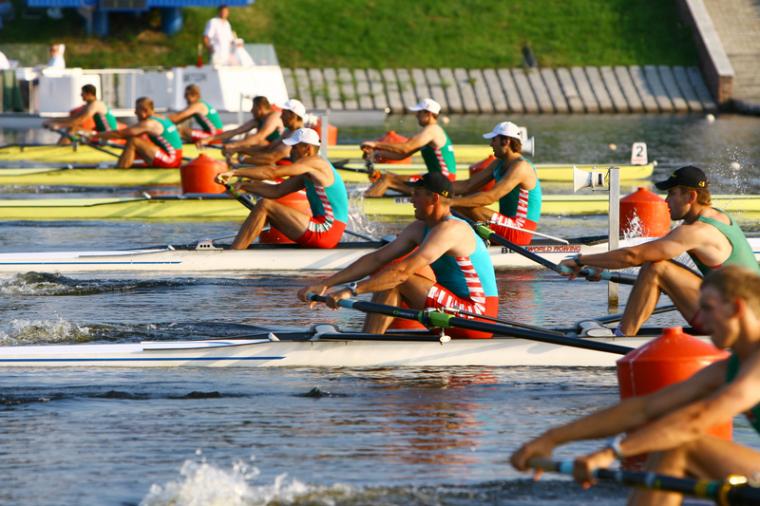

Mountain biking on water…there’s an odd image for you. But it’s how the discipline of coastal rowing is being described.
A recent article in Inside The Games noted that World Rowing's plan to introduce coastal rowing was described as "a solid proposal which will need to be considered for future Games.”
USRowing describes the discipline as rowing along the coast and out into the ocean (or other large bodies of water). In contrast to traditional Olympic-style rowing, coastal rowing takes place in rougher waters and competitors must deal with not only the surf but also other challenges that occur in open waters, such as tides and currents.
Thus, the “mountain bike” analogy.
Coastal rowing uses different equipment; in contrast with the sculls used in college and other traditional rowing, coastal rowing uses wider, more stable sculling boats. Their stability makes it easier for newcomers to the sport to learn versus their racing shell cousins used in Olympic rowing. The boats used are singles, doubles and quads with coxswains.
Coastal rowing races are broken up into two categories, coastal rowing and beach sprints. There are seven events currently offered at the World Rowing Coastal Championship, including the CM1x, CW1x, CM2x, CW2x, CM4x+, CW4x+, and the CMix2x. The events currently at the World Rowing Beach Sprint Finals are the CM1x, CW1x, CMix2x, CMix4x+, CJM1x, CJW1x, CJM2x, CJW2x, and CJMix2x.
Coastal rowing is generally a 6-8-kilometer race around one or more buoys and back. All boats line up in a category and start the race together.
“We're excited for opportunity with USRowing because it can bridge the gap between open-water rowing and flat-water rowing and show that people don't have to be team open water or team flat water, but instead can be members of one rowing community," said John Rhee, a member of the working group on the Coastal Rowing program. "Coastal rowing is the mountain biking of rowing -- some people call it the adventurous version of rowing. Navigating the currents, wind, and waves make it particularly challenging and exciting."
According to Inside The Games, the IOC has been trying to phase out lightweight events in rowing since 2017, and coastal rowing could maintain much-needed gender equity in the program while being suitable to share facilities with the sailing venue, thus eliminating the need for any additional sites. Additionally, because it tends to attract a younger group of athletes, as well as a younger audience, the IOC (laser-focused on the younger viewership), is interested in pursuing it.
World Rowing used reports and analytics to showcase the viability of coastal rowing.
While the existing rowing program of 14 rowing events (the same as those used in Tokyo) will be contested for 2024, rowing will need to reduce its overall athlete count by 24 to 502 (from the current 526 for 2024).
Not a problem, says the IOC, considering the location of the 2028 Games. In fact, Inside The Games notes, IOC told World Rowing that the "beach nature of the Coastal Rowing events could represent a very strong fit with the vision and venue landscape of Los Angeles."
There may be other changes afoot for LA 2028. The 2021 World Ordinary Rowing Congress documentation did not mention the discussions with LA28 about moving the rowing competition from the proposed Lake Perris State Recreation Area in Riverside County to the Long Beach Marine Stadium, site of the 1932 Games, but which would now require a short course of 1500m instead of the usual 2000m.
Additionally, USRowing noted, “since coming together over the past month, the working group has established sub-groups to focus on two key areas: Athlete Identification, Development and National Team Pathways and Coastal Education, Club and Regional Event Development. These sub-groups will look at both short-term initiatives to implement in 2021, as well as longer-term goals through 2024 and beyond.
With the likely addition of coastal rowing events to the Olympic program and the continued development of the World Rowing Beach Sprints Finals and World Rowing Coastal Championships, the Athlete Identification, Development and National Team Pathways group will initially focus on:
- National team trials procedures and event planning
- Near-term process of athlete identification and potential ID camps
- Long-term planning surrounding junior/U23/senior athlete identification and the national team pathway starting with selection of the Beach Sprints National Team to compete at the 2021 World Rowing Beach Sprints Finals.”
The Coastal Education, Club and Regional Event Development group will look at the broader picture of coastal rowing development, including non-FISA-class, open-water boats. Its focus will include:
- Educational programming and content for clubs, coaches and referees
- Event development at the regional and national level
- Coastal messaging and interaction with the rowing community at large
"We're excited for the partnership with USRowing because it's important to get the message out that coastal rowing is here," Rhee said. "People who want to learn more should keep an eye out for coastal rowing tents and equipment displays at rowing events and check out beach sprints online. They're really exciting!"

